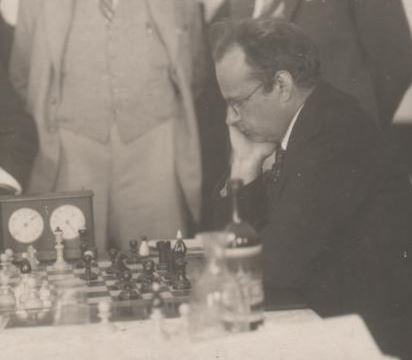Was Aron Nimzowitsch ever a World Chess Champion? This question arises naturally for anyone familiar with his immense contributions to chess. The short answer is no—he never held the title of World Chess Champion. However, to focus solely on this fact would overlook the true essence of Nimzowitsch’s legacy. His innovative ideas and revolutionary strategies, particularly in the development of the “hypermodern” school of thought, left an indelible mark on the world of chess.
Although Nimzowitsch did not win the highest title, his strategic brilliance and influence in reshaping chess theory established him as one of the most important figures in the game’s history. His work continues to be studied and revered, and he is remembered as a towering intellectual force who transformed the way chess is played and understood.
Who Was Aron Nimzowitsch?
Aron Nimzowitsch was born in 1886 in Riga, Latvia, and rose to prominence during the early 20th century. His early passion for chess led him to become one of the most prominent players of his time. By the 1920s and 1930s, he was recognized as one of the top grandmasters in the world.
Nimzowitsch competed alongside giants like José Raúl Capablanca, Alexander Alekhine, and Emanuel Lasker, often holding his own in this elite company. Despite never becoming World Champion, his strategic innovations were highly respected. His peak period saw him participate in many major tournaments, and he was regarded as one of the world’s top players for several years.
What made Nimzowitsch unique was his ability to challenge the conventional thinking of his era. While other players focused on directly occupying the center of the board, Nimzowitsch advocated for a more nuanced, indirect control, which became the cornerstone of the hypermodern school of chess. His contributions went beyond mere competition; they shaped how generations of players approached the game.
Nimzowitsch’s Contributions to Chess
Introduction to Hypermodernism
Aron Nimzowitsch was a central figure in the development of hypermodern chess, a school of thought that challenged the classical approach to the game. Classical chess strategy emphasized controlling the center of the board by directly occupying it with pawns and pieces. Nimzowitsch revolutionized this thinking by advocating for indirect control of the center. He believed that placing pressure on the center from a distance with pieces such as knights and bishops could be just as effective, if not more so, than traditional methods. This approach allowed for greater flexibility and encouraged opponents to overextend, creating weaknesses that could be exploited later in the game.
Nimzowitsch’s hypermodern strategies opened up new possibilities for positional play, giving rise to unconventional openings like the Nimzo-Indian Defense, which is still widely used in modern chess. His innovative ideas reshaped how players thought about the center and the dynamics of piece placement, cementing his place as one of chess’s greatest strategists.
Key Concepts from My System
Nimzowitsch’s groundbreaking book My System, published in the 1920s, remains a foundational text for chess players. It introduced several key concepts that were revolutionary at the time:
- Prophylaxis: The idea of preventing your opponent’s plans before they materialize. Rather than focusing solely on your own strategy, Nimzowitsch emphasized anticipating and neutralizing the opponent’s moves.
- Pawn Structure: He detailed the importance of a strong pawn structure in both attack and defense, explaining how weak pawns or overextended positions could lead to a loss of control.
- Piece Placement: Nimzowitsch stressed the significance of placing pieces in flexible positions where they could control key squares without overcommitting. His emphasis on maneuverability and piece coordination over brute force was a hallmark of his thinking.
My System has had an enduring influence, shaping the development of positional chess theory and being studied by generations of players seeking to understand the deeper, more subtle aspects of chess.
Influence on Modern Chess
The principles introduced by Nimzowitsch continue to be a cornerstone of modern chess theory. His hypermodern ideas are still applied today, with top players often adopting indirect methods of controlling the center and emphasizing positional play. Openings like the Nimzo-Indian Defense and the King’s Indian Defense, which Nimzowitsch helped popularize, remain favorites among grandmasters.
Even outside of specific openings, his broader concepts—such as prophylaxis and flexible piece placement—are central to how elite players approach the game. Nimzowitsch’s influence is seen in the works of later grandmasters, such as Tigran Petrosian, who was known for his deep prophylactic thinking. His contributions continue to shape chess at the highest levels.

Why Nimzowitsch Was Never World Champion
Contemporaries in Chess
Although Nimzowitsch was one of the top players of his time, he competed in an era dominated by some of the greatest names in chess history. José Raúl Capablanca, Alexander Alekhine, and Emanuel Lasker were all World Chess Champions during Nimzowitsch’s career, and they were formidable opponents. Capablanca, known for his clean and simple style, was World Champion from 1921 to 1927. Alekhine, famous for his tactical brilliance, held the title from 1927 to 1935, and Lasker, a chess legend with a reign that lasted 27 years, was champion from 1894 to 1921.
Nimzowitsch played against all three of these giants, holding his own in many games but never quite surpassing them. The intense competition of the era meant that only a few players were able to rise to the top and challenge for the World Championship.
Tournament Successes and Limitations
Nimzowitsch enjoyed significant success in international tournaments and was often considered one of the strongest players in the world. He won prestigious events such as Carlsbad 1929 and came second in numerous top-level competitions. However, despite his many victories and his status as one of the world’s leading players, he never reached the level of being a World Championship contender.
One possible explanation for this is Nimzowitsch’s occasional inconsistency. While he could perform brilliantly, he sometimes struggled in key moments against the absolute best, such as Capablanca and Alekhine. This prevented him from securing the match results needed to challenge for the title.
Historical Context
Becoming World Champion during Nimzowitsch’s era was not only a matter of skill but also of opportunity. At that time, the reigning World Champion had significant control over who they would face in a title match, often requiring substantial financial backing from the challenger. Alekhine, for instance, was selective in choosing his opponents, making it difficult for many talented players, including Nimzowitsch, to secure a title shot.
Additionally, there were only a handful of top players deemed worthy of challenging for the championship, meaning that even elite players like Nimzowitsch faced significant barriers to reaching the pinnacle of the chess world. While his strategic brilliance was undeniable, the combination of tough competition and historical circumstances prevented him from ever competing for the World Championship title.

Nimzowitsch’s Lasting Legacy
Impact on Chess Strategy: Nimzowitsch’s groundbreaking strategies, such as overprotection, the blockade, and the concept of controlling the center with pieces instead of pawns, reshaped the way chess is understood and played. These innovative ideas shifted the focus from immediate attacks to long-term positional play, offering players new ways to think about gaining strategic advantages. His hypermodern approach encouraged flexibility and emphasized controlling key squares rather than adhering to classical opening principles, ultimately expanding the tactical and strategic horizons of the game.
Influence on Modern Grandmasters: Nimzowitsch’s contributions continue to resonate in the strategies employed by modern grandmasters. Players like Magnus Carlsen and Vladimir Kramnik have adopted and refined positional techniques that echo Nimzowitsch’s ideas. Schools of thought in contemporary chess still value the principles he laid down, including the subtle control of the board and a deeper understanding of positional imbalances. His influence on the hypermodern school of chess, as well as in current opening systems like the Nimzo-Indian Defense, is a testament to the enduring relevance of his strategies.
Acknowledgment as a Chess Thinker: Although Nimzowitsch never claimed the World Champion title, his profound impact on chess theory and strategy stands equal to, if not surpassing, many champions of his time. His theoretical advancements in the game have secured his place as one of the most important and influential thinkers in chess history. Nimzowitsch’s ideas continue to be studied, revered, and applied, ensuring his legacy lives on.
Conclusion
Nimzowitsch’s strategic innovations forever altered the landscape of chess, proving that his contributions outweigh his absence from the World Championship title. His brilliance in reimagining chess strategy as a more nuanced and dynamic contest continues to influence modern play. As a revolutionary thinker, Nimzowitsch has earned his place among the greatest minds in the game, his legacy etched in chess history.
To truly appreciate Nimzowitsch’s contributions, readers are encouraged to explore his games and writings, particularly his seminal work My System. Through his books and legendary encounters, players can gain deeper insights into the art of chess and witness firsthand the genius that reshaped the game’s strategic core.
FAQ
1. Who was Aron Nimzowitsch?
Aron Nimzowitsch was a Latvian-born chess player and influential chess theorist who made significant contributions to chess strategy during the early 20th century. He is widely recognized for his development of the hypermodern school of chess, which emphasized controlling the center with pieces rather than pawns.
2. What is Aron Nimzowitsch famous for?
Nimzowitsch is best known for his groundbreaking chess strategies and theories, including the concepts of overprotection, blockade, and prophylaxis. His book My System is one of the most important works in chess literature and continues to be studied by players at all levels.
3. What is the Hypermodern School of Chess?
The hypermodern school, championed by Nimzowitsch, challenged classical chess principles that emphasized pawn control of the center. Instead, hypermodernism advocates for controlling the center with pieces from a distance, allowing more flexibility and creating dynamic positions.
4. What are some of Nimzowitsch’s most famous contributions to chess strategy?
Nimzowitsch introduced several revolutionary concepts, including:
- Overprotection: Defending a strong piece or square more than necessary to increase its strength.
- Blockade: Strategically using pieces to block enemy pawns, especially in closed positions.
- Prophylaxis: Anticipating and preventing the opponent’s plans before they can fully develop.
5. Did Aron Nimzowitsch ever become a World Chess Champion?
No, despite his immense contributions to chess theory and strategy, Nimzowitsch never won the World Chess Championship. However, his impact on the game has been just as profound as many world champions.
6. What is My System, and why is it important?
My System is Nimzowitsch’s most famous work, outlining his chess philosophy and innovative ideas. It is regarded as one of the most influential chess books ever written, offering a systematic approach to positional play and hypermodern strategy.
7. How has Nimzowitsch influenced modern chess players?
Many modern grandmasters, including players like Magnus Carlsen and Vladimir Kramnik, have been influenced by Nimzowitsch’s ideas, particularly in their positional play and opening choices. His ideas remain relevant in contemporary chess, and his strategies are regularly employed in elite tournaments.
8. What openings are named after Nimzowitsch?
Several openings are named after Nimzowitsch, with the most famous being the Nimzo-Indian Defense (1. d4 Nf6 2. c4 e6 3. Nc3 Bb4), which is still widely used in modern chess. Other notable openings include the Nimzowitsch Defense (1. e4 Nc6).
9. What made Nimzowitsch’s style unique compared to other players of his time?
Nimzowitsch’s style was distinct in that he favored deep positional play over immediate tactical attacks. He focused on long-term strategic planning, often using unconventional methods to control key squares and prevent opponents from executing their plans.
10. Where can I learn more about Aron Nimzowitsch’s games and ideas?
You can explore Nimzowitsch’s contributions by reading his book My System or studying his famous games, many of which are annotated and available online. Additionally, chess databases and platforms like ChessBase or Lichess provide access to his recorded games and analyses.
